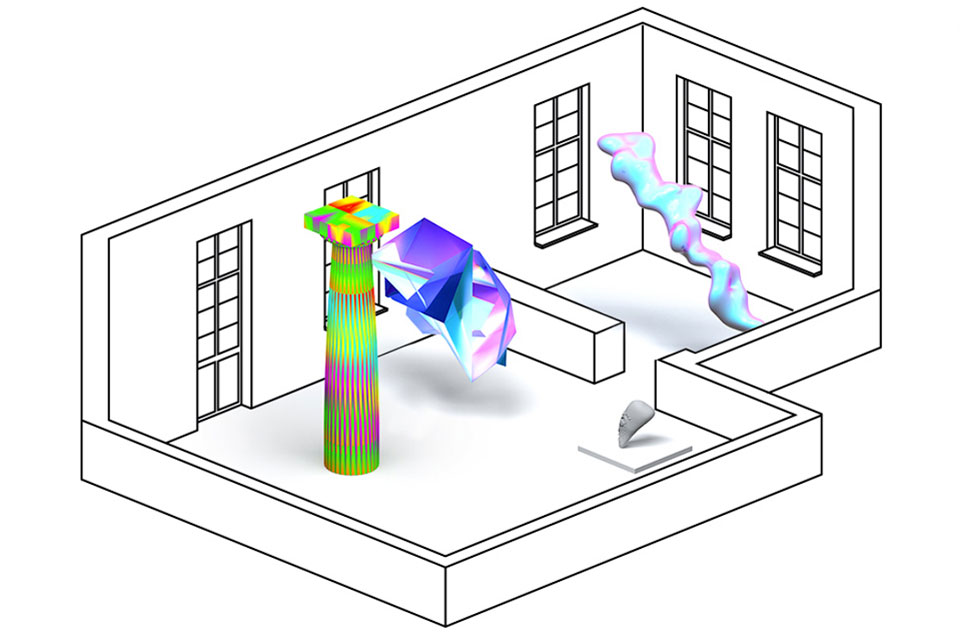
Access to the Net: how a virtual gallery works
German curator Manuel Rossner came up with the idea of creating a virtual art-gallery in 2011. He was inspired by the Belgian Museum of contemporary art which lasted on the seaside for a day before being destroyed by the usual tide in the morning.
Today CERMA, founded by Manuel, has three exhibitions. Instead of the hallways it has pixel spaces which allow visitors observe art-objects in 3D format.
Bird In Flight interviewed Manuel on the subject of his sources of inspiration from the real world, specifics of organizing exhibitions on the Net and new formats of art.

28-years old Manuel Rossner,
curator, founder of gallery CERMA
Studied at École des Arts-Décoratifs in Paris and Hochschule für Gestaltung Offenbach. Develops his work on the border of real objects and their representation, which turned into the starting point of foundation of the virtual gallery in 2012. Important part of his interests lies within creating images that are fully or partially independent from the physical object, as well as their influence on our perception. Resides in Paris, France.
How long did it take to move up from the idea of a virtual gallery to the opening of first exhibition?
About half a year. The idea appeared in 2011, and it took me another year to realize that I indeed wanted to pursue bringing this project to life. Creating the website took quite a bit of time as well: many technical questions had to be solved, for instance, how to tune up representation of the objects in 3D. Ever since the resource has stayed in the state of constant development.
How do the openings of the exhibitions happen in CERMA, perhaps you came up with your own digital rituals?
At the opening of the very first exhibition the ceremonial part with speeches took place offline at a real expositional space where the showcase pieces were displayed. For example, there was a real life video-installation by Jeremy Bailey. At times during the exhibition hours his video in real space was turned off and when visitors appeared I switched on the installation on my notebook. They got to see the gallery, they got to see Bailey, but online. They would be able to see it just the same without having to leave their house.
The first online-ritual arrived at the opening of the exhibition SPAMM. We sent out invitations through Facebook. Instead of arriving at the noted time to the gallery, visitors got on the internet and joined a video-chat. They watched the showcase at home while socializing and meeting each other through chat-room – it slightly reminded a party for students from different countries. Also, the chat-room had a DJ who played some ambiance music.
How do you select the artists and their work?
Initially we decide on the concept for an exhibition, then we choose potential participants. Of course we pay attention to the technical side of the work, though it’s not crucial. But a common picture, not connected to modern technologies – a common picture, not connected to the modern technologies, would be illogical to showcase here. At times we have those too, yet we prefer volumetric and digital art-objects. I asked to find Manuel Fernandez for the latest exhibition (Spanish modern artist whose specialty is the pop-culture and internet themes – editor’s note). His work was displayed at the exhibition as well.
{
“img”: “/wp-content/uploads/2014/05/what-we-call-sculpture.jpg”,
“alt”: “Manuel Rossner virtual gallery”
},
{
“img”: “/wp-content/uploads/2014/05/Manuel-Rossner-virtual-gallery-1.jpg”,
“alt”: “Manuel Rossner virtual gallery 1”
},
{
“img”: “/wp-content/uploads/2014/05/Manuel-Rossner-virtual-gallery-2.jpg”,
“alt”: “Manuel Rossner virtual gallery 2”
},
{
“img”: “/wp-content/uploads/2014/05/Manuel-Rossner-virtual-gallery-3.jpg”,
“alt”: “Manuel Rossner virtual gallery 3”
},
{
“img”: “/wp-content/uploads/2014/05/Manuel-Rossner-virtual-gallery-4.jpg”,
“alt”: “Manuel Rossner virtual gallery 4”
},
{
“img”: “/wp-content/uploads/2014/05/SPAMM.jpg”,
“alt”: “Manuel Rossner virtual gallery 5”
},
{
“img”: “/wp-content/uploads/2014/05/Manuel-Rossner-virtual-gallery-6.jpg”,
“alt”: “Manuel Rossner virtual gallery 6”
},
{
“img”: “/wp-content/uploads/2014/05/Manuel-Rossner-virtual-gallery-7.jpg”,
“alt”: “Manuel Rossner virtual gallery 7”
}
Two exhibitions that took place at CERMA are titled What We Call Painting and What We Call Sculpture. Do you consider creating one titled What We Call Photography and how would you see its concept?
The challenge is that all art-objects – whether it’s a sculpture, or a video, or a painting, are represented in CERMA in the photo format. That is why, if we do decide to do a photo exhibition, we need to determine what is it that we consider photography.
If we create a photo showcase, it will be on the subject of contemporary photography created with help of the computer technologies. Within classic photography the author writes “with the light”, his role is passive – the time interval, the moment of capture is vital. Creating photos via computer technologies is drawn to the work of the artist: the author decides himself where the sun should be and all other nuances. Time here is under the photographer’s control. Nowadays we deal with the peculiar mix of these two types of photography. Often it is impossible to determine whether the image is real or edited.
We can also engage “personal” photography like the one practiced with the cameras of mobile phones. It’ll be interesting to combine all these concepts within one exhibition. I think it’s a possibility.
Internet is the place where it’s hard to concentrate, a person browses through information and is often tempted to switch its sources. Are you concerned that the viewer will not go through the whole exhibition?
If someone is not interested in our project, it’s okay, that’s what internet is – you choose what you’d like to see. But I am, naturally, concerned with keeping people on our site, that’s why I try to improve connection with our visitors. For example, we implemented registration which allows access to new pages of the site. There is no leaving a comment option just yet, but they can still reach me via email.
Describe the audience of CERMA.
Many foreigners enter the site. I think the majority of them are our artists’ friends. During registration for the most recent exposition guests had to put in their date of birth. I recall that there was a visitor among them born in 1995. It meant that the showcase drew interest of the very young people.
The audience is various. Even those who do not deal with the art are able to perceive virtual expositions as part of their everyday online-life — like, for instance, computer games.
It’s difficult to find a gallery that isn’t confusing on the site of CERMA.
When CERMA is having an ongoing exposition, it is always on the main page of the site. Right now we don’t have any major exhibitions, that’s why what visitors see is the archives of the past events. I plan to simplify the access to the archives for the registered guests, we are presently in the process of testing this function.
{
“img”: “/wp-content/uploads/2014/05/reg.jpg”,
“alt”: “Manuel Rossner virtual gallery 8”
},
{
“img”: “/wp-content/uploads/2014/05/Manuel-Rossner-virtual-gallery-9.png”,
“alt”: “Manuel Rossner virtual gallery 9”
},
{
“img”: “/wp-content/uploads/2014/05/contributor.jpg”,
“alt”: “Manuel Rossner virtual gallery 10”
}
How successful do you consider the project from the commercial as well as the ideological standpoint?
It is successful, because I see plenty of opportunities for its growth, plus I have the desire to keep going with it. I follow people’s remarks – they also find the idea of virtual gallery quite interesting. As to the traffic, every exhibition is seen by about 1000 guests.
Presently the access to the gallery is free, but in the future it would be great to earn a profit off the project – to continue improving it. Now we are wrapping up work on technical representation of active exhibitions, and preparing a new showcase to be open by autumn. The subject can be described as the connection of the digital artists with nature – we will attempt to determine whether these concepts are popular or not. Next year we want to present four more exhibitions.
Do you think that in time virtual expositions will be able to replace the offline-museums and cultural centers?
It is probable that these two forms will begin interacting more closely. Museum displays and galleries are important. First, it’s a personal acquaintance with the art, second – it’s the opportunity to escape people and routine. That is why offline-expositions will always be valuable. Still, traditional institutions have to find a way to closely cooperate with the new art formats. Young artists are coming to light and it’s very unlikely that they will stay within the classical spaces and ways of self-expression.
New and best




